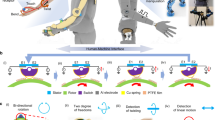Summary
Since the beginning of teleoperation, exoskeleton systems have been considered as man-machine interfaces at the master level. Exoskeletons are robotics systems, that can be put on by the human operator, with a kinematic structure similar to that of operator’s upper or lower limbs. They have a twofold functionality: a) to record the movement at the level of human limb, b) to generate forces at the points of attachment with the human limb. The first examples of exoskeletons can be traced back to systems for the arm and the hand specifically designed for replicating grasping and contact forces to the operator. Nowadays exoskeleton systems are successfully employed also as body extenders for human power augmentation and rehabilitation. This chapter describes different types of exoskeleton systems from the point of view of mechanical and control design, and presents different examples of applications from the current state of the art.
Access this chapter
Tax calculation will be finalised at checkout
Purchases are for personal use only
Preview
Unable to display preview. Download preview PDF.
Similar content being viewed by others
References
M. Bergamasco. Force replication to the human operator: the development of arm and hand exoskeletons as haptic interfaces. In Proceedings of 7th International Symposium on Robotics Research, 1997.
AK Bejczy and JK Salisbury Jr. Controlling remote manipulators through kinesthetic coupling. COMP. MECH. ENG., 2(1):48–58, 1983.
BM Jau. Anthropomorhic Exoskeleton dual arm/hand telerobot controller. In Intelligent Robots, 1988., IEEE International Workshop on, pages 715–718, 1988.
A. Nahvi, DD Nelson, JM Hollerbach, and DE Johnson. Haptic manipulation of virtual mechanisms from mechanical CADdesigns. In Robotics and Automation, 1998. Proceedings. 1998 IEEE International Conference on, 1, 1998.
T. Nef and R. Riener. ARMin-Design of a Novel Arm Rehabilitation Robot. In Rehabilitation Robotics, 2005. ICORR 2005. 9th International Conference on, pages 57–60, 2005.
A. Frisoli, Marcello Carrozzino, S. Marcheschi, F. Salsedo, and M. Bergamasco. In Research in Interactive Design Proceedings of Virtual Concept, chapter Haptic systems for simulation of primary commands of cars. Springer, 2005.
M. Bergamasco, B. Allotta, L. Bosio, L. Ferretti, G. Parrini, G.M. Prisco, F. Salsedo, and G. Sartini. An arm exoskeleton system for teleopera-tion and virtual environments applications. In IEEE Int.Conf.On Robotics and Automation, pages 1449–1454, 1994.
N. Tsagarakis, DG Caldwell, and GA Medrano-Cerda. A 7 DOF pneumatic muscle actuator (pMA) powered exoskeleton. In Robot and Human Interaction, 1999. ROMAN’ 99. 8th IEEE International Workshop on, pages 327–333, 1999.
Y.S. Kim, S. Lee, C. Cho, M. Kim, and C.W. Lee. Anew exoskeleton-type masterarm with force reflection based on the torque sensor beam. In Robotics and Automation, 2001. Proceedings 2001 ICRA. IEEE International Conference on, 3, 2001.
D. McAffee and P. Fiorini. Hand controller design requirements and performances issues in telerobotics. In Proc. of ICAR, International Conference on Advanced Robotics, 1991.
G.C. Burdea. Force and touch feedback for virtual reality. John Wiley & Sons, Inc. New York, NY, USA, 1996.
F. Salsedo, A. Dettori, A. Frisoli, F. Rocchi, M. Bergamasco, and M. Franceschini. Exoskeleton interface apparatus. Patent N. WO2004058458.
A. Frisoli, F. Rocchi, S. Marcheschi, A. Dettori, F. Salsedo, and M. Bergamasco. A new force-feedback arm exoskeleton for haptic interaction in virtual environments. In Haptic Interfaces for Virtual Environment and Teleoperator Systems, 2005. WHC 2005. First Joint Eurohaptics Conference and Symposium on, pages 195–201, 2005.
S. Marcheschi, A. Frisoli, CA Avizzano, and M. Bergamasco. A Method for Modeling and Control Complex Tendon Transmissions in Haptic Interfaces. In Robotics and Automation, 2005. Proceedings of the 2005 IEEE International Conference on, pages 1773–1778, 2005.
F. Barbagli, C. Avizzano, and M. Bergamasco. The Hand Force Feedback: Analysis and Control of a Haptic Device for the Human Hand. In IEEE International Conference on System Man and Cybernetics, 2:989–994, 2000.
E. Garcia, JM Sater, and J. Main. Exoskeletons for human performance augmentation (EHPA): A program summary. Journal of Robotics Society of Japan, 20(8):44–48, 2002.
R.S. Mosher. Handyman to Hardiman. Society of Automotive Engineers, 1967.
H. Kawamoto, S. Kanbe, and Y. Sankai. Power Assist Method for HAL3 Estimating Operator Intention Based on Motion Information. In Proceedings of IEEE ROMAN, 2003.
http://www.sarcos.com.
A. Zoss, H. Kazerooni, and A. Chu. On the mechanical design of the Berkeley Lower Extremity Exoskeleton (BLEEX). In Intelligent Robots and Systems, 2005.(IROS 2005). 2005 IEEE/RSJ International Conference on, pages 3465–3472, 2005.
Author information
Authors and Affiliations
Editor information
Editors and Affiliations
Rights and permissions
Copyright information
© 2007 Springer-Verlag Berlin Heidelberg
About this chapter
Cite this chapter
Bergamasco, M., Frisoli, A., Avizzano, C.A. (2007). Exoskeletons as Man-Machine Interface Systems for Teleoperation and Interaction in Virtual Environments. In: Ferre, M., Buss, M., Aracil, R., Melchiorri, C., Balaguer, C. (eds) Advances in Telerobotics. Springer Tracts in Advanced Robotics, vol 31. Springer, Berlin, Heidelberg. https://doi.org/10.1007/978-3-540-71364-7_5
Download citation
DOI: https://doi.org/10.1007/978-3-540-71364-7_5
Publisher Name: Springer, Berlin, Heidelberg
Print ISBN: 978-3-540-71363-0
Online ISBN: 978-3-540-71364-7
eBook Packages: EngineeringEngineering (R0)




